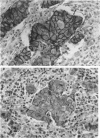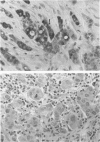Abstract
The major objectives of this study were twofold: to determine 1) if growth factors or growth factor receptors were expressed similarly or differently in a clinically well-characterized group of breast cancer patients and 2) if these phenotypic characteristics were associated with any of the commonly used prognostic parameters. Formalin-fixed paraffin-embedded tumor tissue from 51 node-positive breast cancer patients were analyzed for the expression of neu, epidermal growth factor-receptor (EGF-R), and transforming growth factor alpha (TGF alpha) using immunoperoxidase staining. Positive membranous staining for neu was observed in 15 (29%) tumors. Over-expression of neu was observed in high-grade, estrogen-receptor-negative tumors (P less than 0.05). Epidermal growth factor receptor was expressed in 22 (43%) of the tumors analyzed and found to a greater degree in estrogen-receptor-negative and high-grade tumors (P less than 0.025). A significant correlation between neu and EGF-R expression was also noted. Tumors expressing membranous staining of neu had a greater than 70% chance of expressing EGF-R (P less than 0.01). Expression of TGF alpha was found in 68% of tumors and TGF alpha was detected in grade 1 and 2 tumor to a greater degree than EGF-R. The authors conclude that assaying tumors for these antigens may give additional phenotypic characteristics that can give further insight into the biology of breast cancer.
Full text
PDF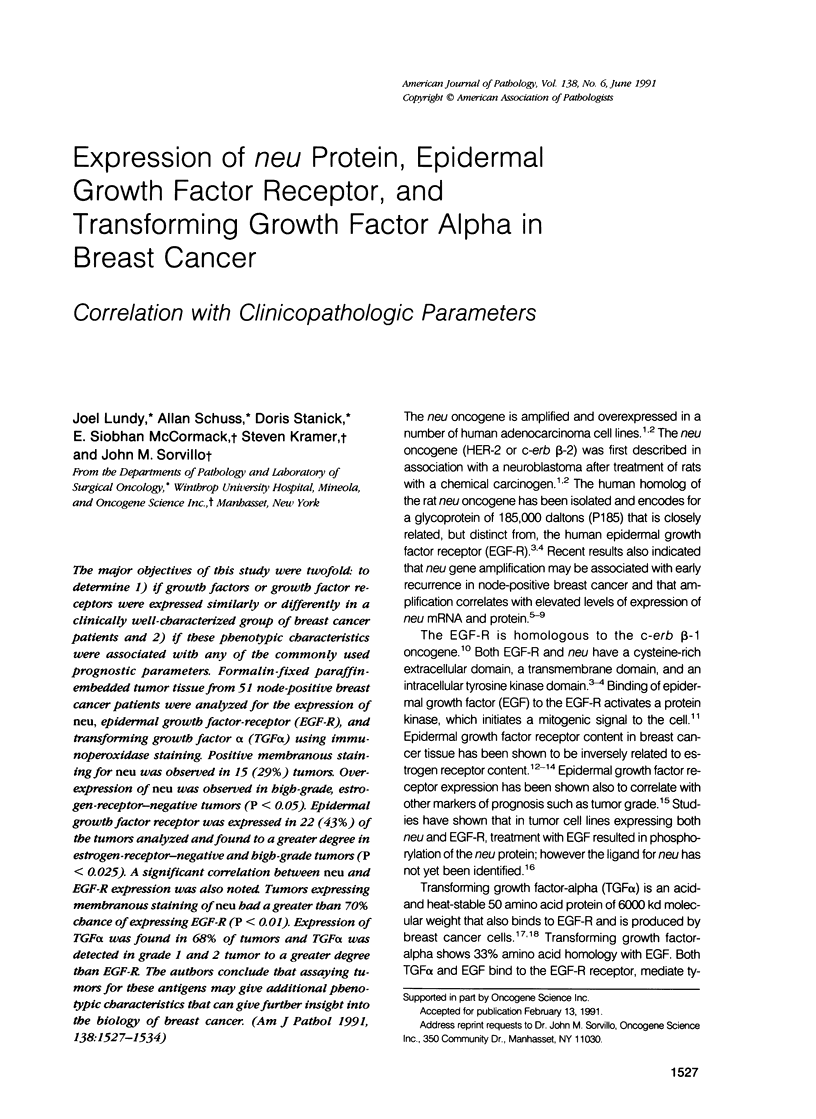
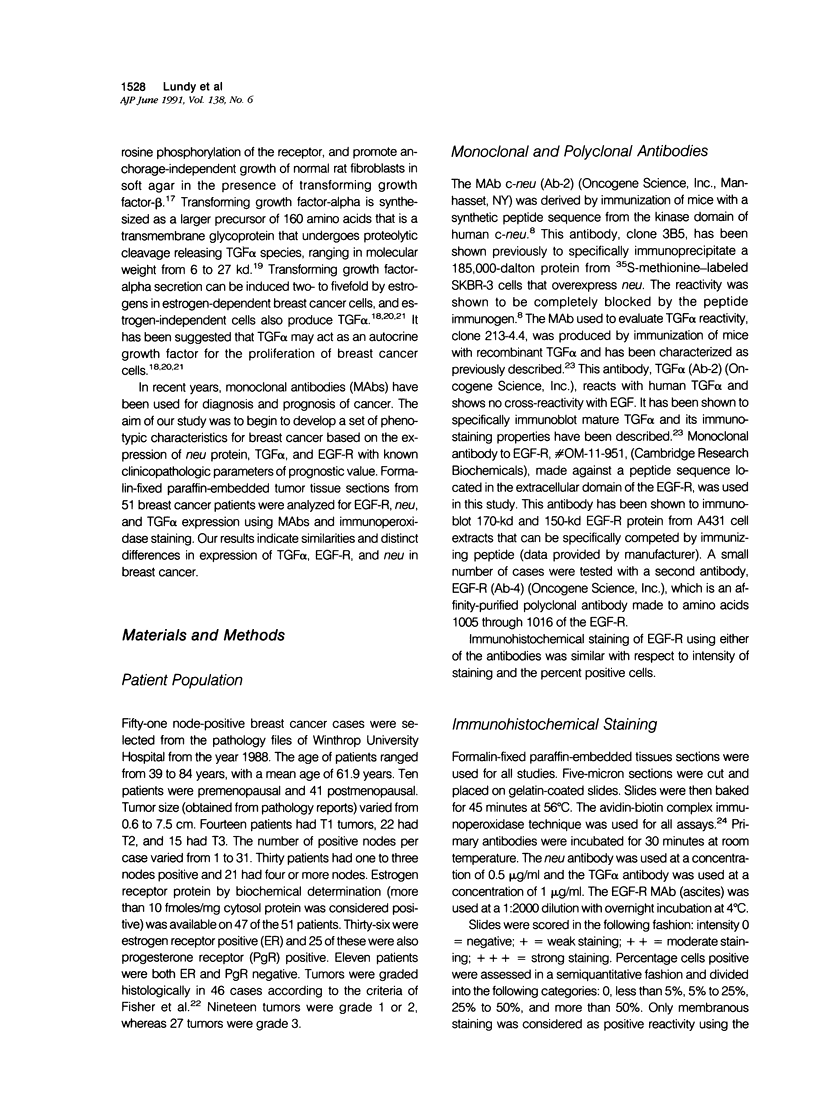

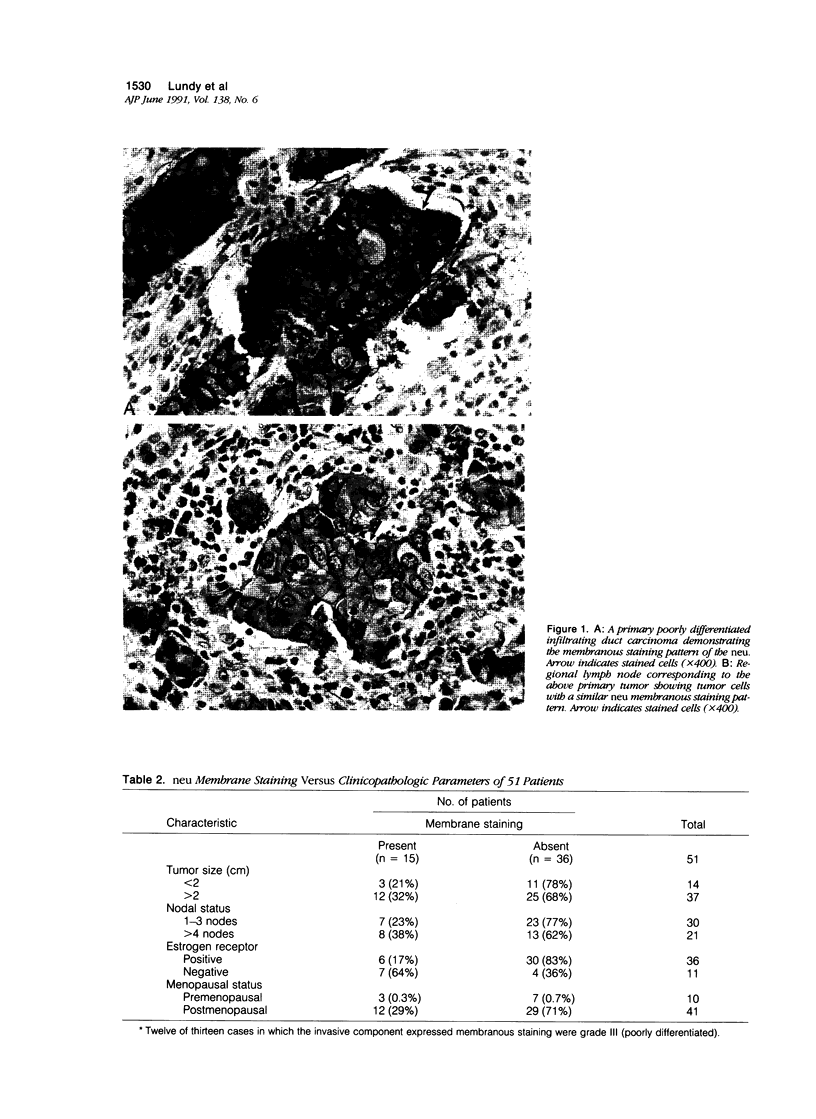
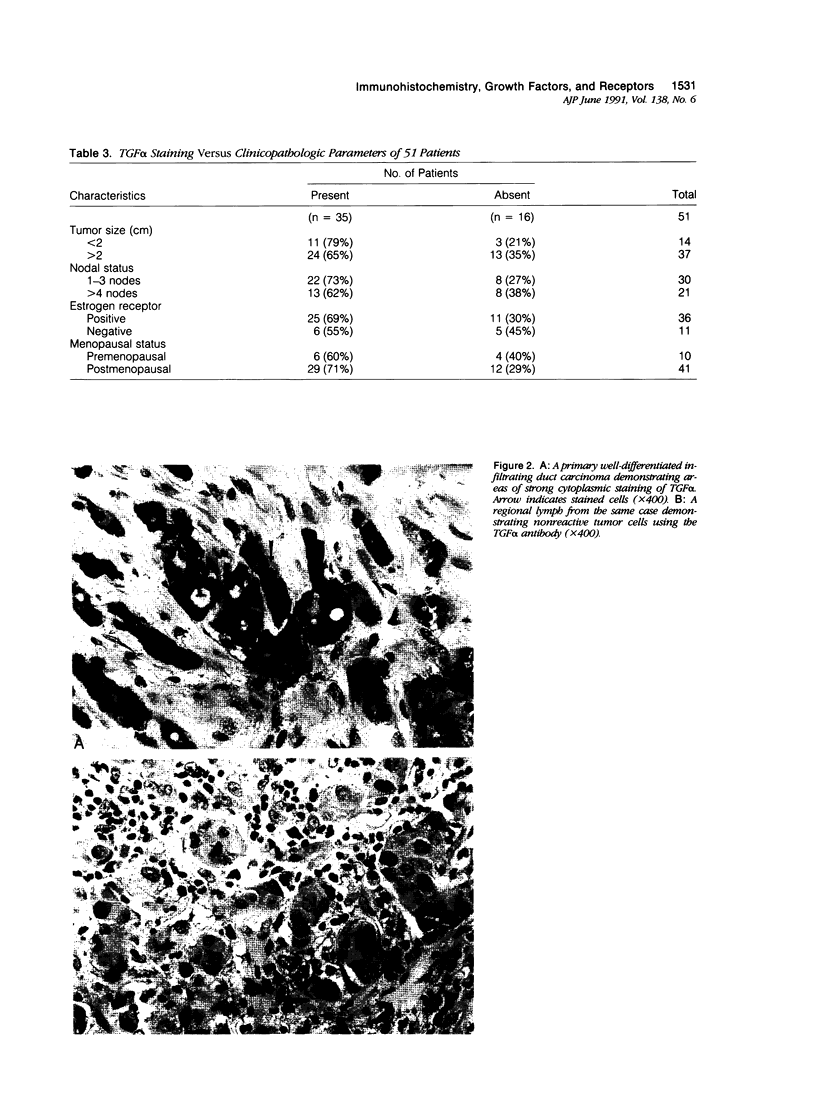
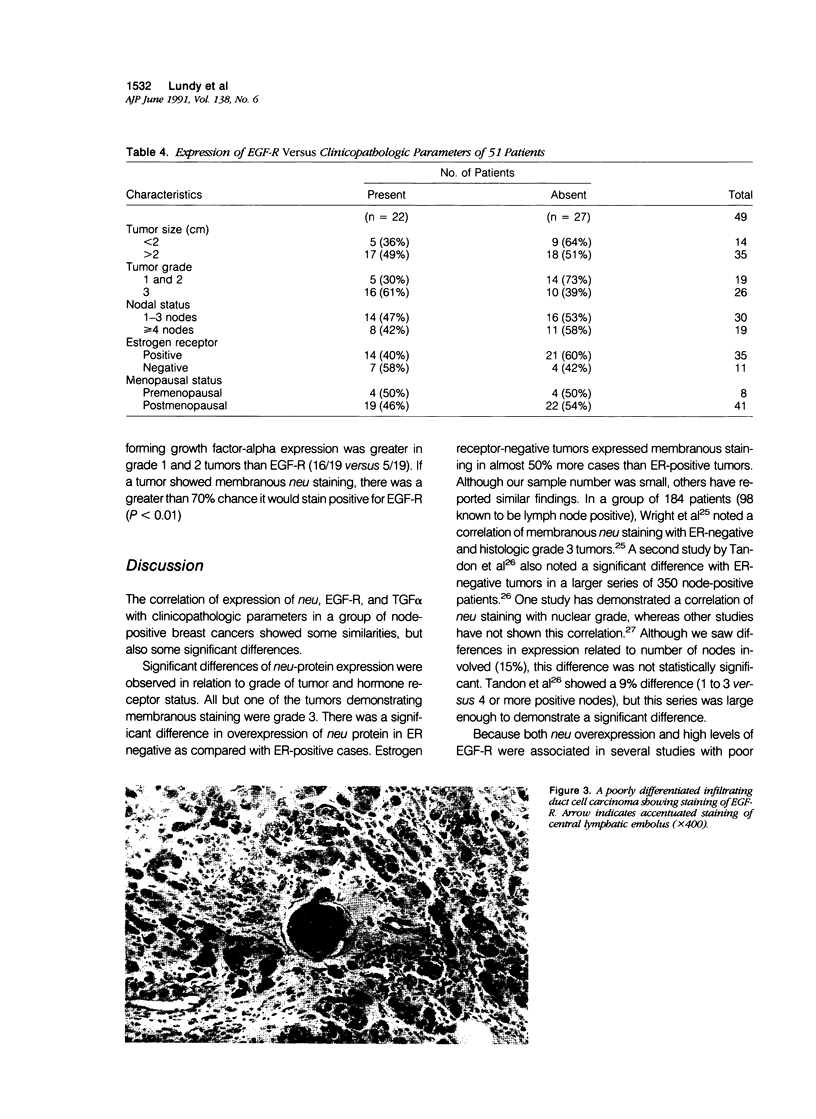
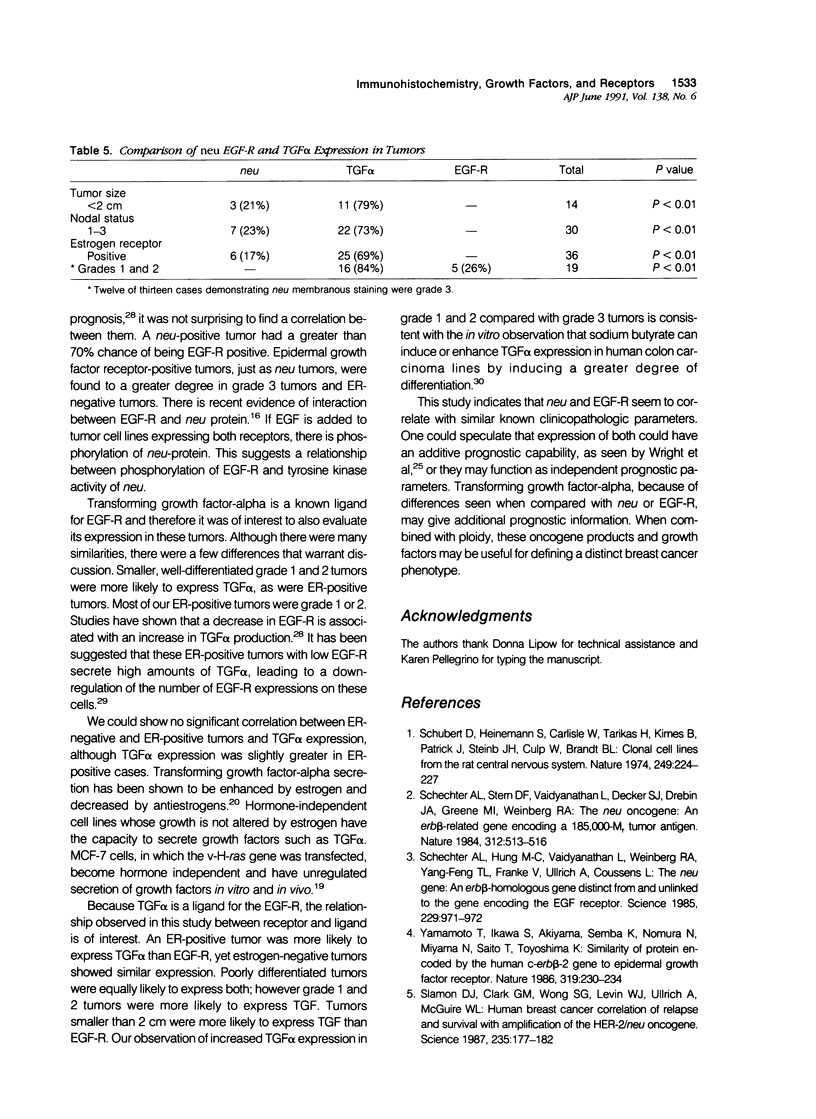
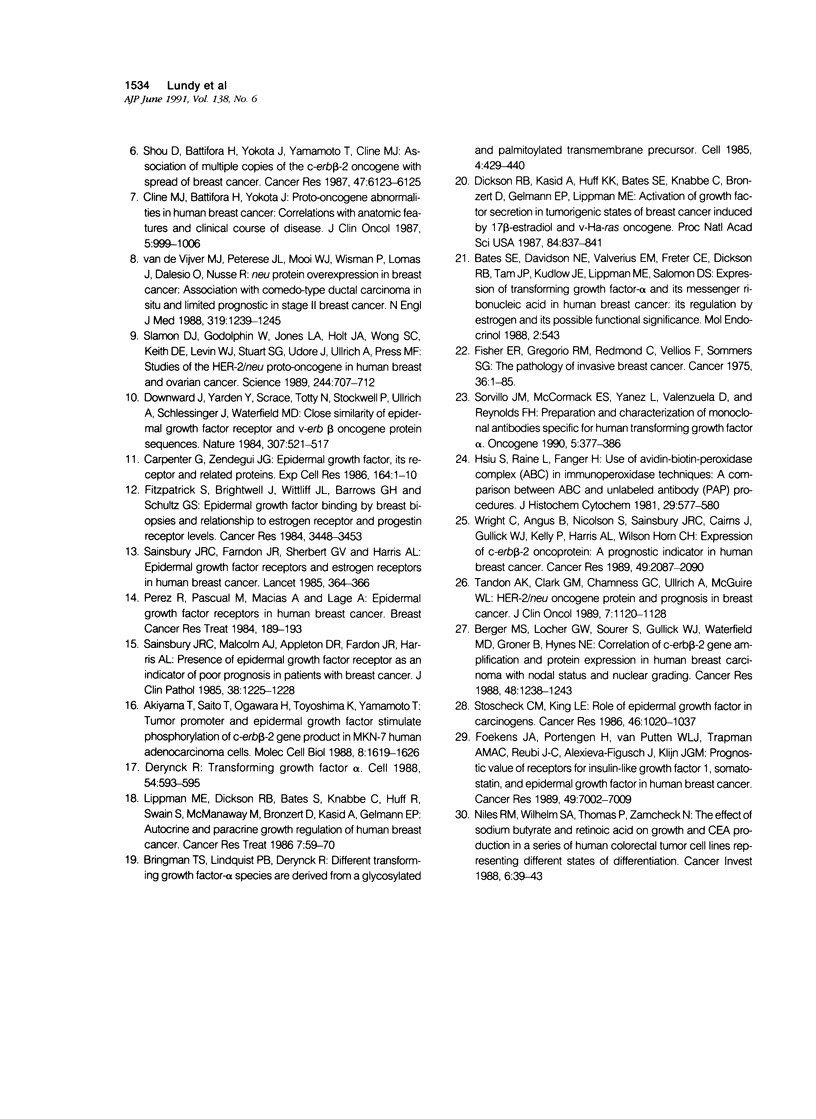
Images in this article
Selected References
These references are in PubMed. This may not be the complete list of references from this article.
- Bates S. E., Davidson N. E., Valverius E. M., Freter C. E., Dickson R. B., Tam J. P., Kudlow J. E., Lippman M. E., Salomon D. S. Expression of transforming growth factor alpha and its messenger ribonucleic acid in human breast cancer: its regulation by estrogen and its possible functional significance. Mol Endocrinol. 1988 Jun;2(6):543–555. doi: 10.1210/mend-2-6-543. [DOI] [PubMed] [Google Scholar]
- Berger M. S., Locher G. W., Saurer S., Gullick W. J., Waterfield M. D., Groner B., Hynes N. E. Correlation of c-erbB-2 gene amplification and protein expression in human breast carcinoma with nodal status and nuclear grading. Cancer Res. 1988 Mar 1;48(5):1238–1243. [PubMed] [Google Scholar]
- Carpenter G., Zendegui J. G. Epidermal growth factor, its receptor, and related proteins. Exp Cell Res. 1986 May;164(1):1–10. doi: 10.1016/0014-4827(86)90449-0. [DOI] [PubMed] [Google Scholar]
- Cline M. J., Battifora H., Yokota J. Proto-oncogene abnormalities in human breast cancer: correlations with anatomic features and clinical course of disease. J Clin Oncol. 1987 Jul;5(7):999–1006. doi: 10.1200/JCO.1987.5.7.999. [DOI] [PubMed] [Google Scholar]
- Derynck R. Transforming growth factor alpha. Cell. 1988 Aug 26;54(5):593–595. doi: 10.1016/s0092-8674(88)80001-1. [DOI] [PubMed] [Google Scholar]
- Dickson R. B., Kasid A., Huff K. K., Bates S. E., Knabbe C., Bronzert D., Gelmann E. P., Lippman M. E. Activation of growth factor secretion in tumorigenic states of breast cancer induced by 17 beta-estradiol or v-Ha-ras oncogene. Proc Natl Acad Sci U S A. 1987 Feb;84(3):837–841. doi: 10.1073/pnas.84.3.837. [DOI] [PMC free article] [PubMed] [Google Scholar]
- Downward J., Yarden Y., Mayes E., Scrace G., Totty N., Stockwell P., Ullrich A., Schlessinger J., Waterfield M. D. Close similarity of epidermal growth factor receptor and v-erb-B oncogene protein sequences. Nature. 1984 Feb 9;307(5951):521–527. doi: 10.1038/307521a0. [DOI] [PubMed] [Google Scholar]
- Fisher E. R., Gregorio R. M., Fisher B., Redmond C., Vellios F., Sommers S. C. The pathology of invasive breast cancer. A syllabus derived from findings of the National Surgical Adjuvant Breast Project (protocol no. 4). Cancer. 1975 Jul;36(1):1–85. doi: 10.1002/1097-0142(197507)36:1<1::aid-cncr2820360102>3.0.co;2-4. [DOI] [PubMed] [Google Scholar]
- Fitzpatrick S. L., Brightwell J., Wittliff J. L., Barrows G. H., Schultz G. S. Epidermal growth factor binding by breast tumor biopsies and relationship to estrogen receptor and progestin receptor levels. Cancer Res. 1984 Aug;44(8):3448–3453. [PubMed] [Google Scholar]
- Foekens J. A., Portengen H., van Putten W. L., Trapman A. M., Reubi J. C., Alexieva-Figusch J., Klijn J. G. Prognostic value of receptors for insulin-like growth factor 1, somatostatin, and epidermal growth factor in human breast cancer. Cancer Res. 1989 Dec 15;49(24 Pt 1):7002–7009. [PubMed] [Google Scholar]
- Hsu S. M., Raine L., Fanger H. Use of avidin-biotin-peroxidase complex (ABC) in immunoperoxidase techniques: a comparison between ABC and unlabeled antibody (PAP) procedures. J Histochem Cytochem. 1981 Apr;29(4):577–580. doi: 10.1177/29.4.6166661. [DOI] [PubMed] [Google Scholar]
- Lippman M. E., Dickson R. B., Bates S., Knabbe C., Huff K., Swain S., McManaway M., Bronzert D., Kasid A., Gelmann E. P. 8th San Antonio Breast Cancer Symposium--Plenary lecture. Autocrine and paracrine growth regulation of human breast cancer. Breast Cancer Res Treat. 1986;7(2):59–70. doi: 10.1007/BF01806790. [DOI] [PubMed] [Google Scholar]
- Niles R. M., Wilhelm S. A., Thomas P., Zamcheck N. The effect of sodium butyrate and retinoic acid on growth and CEA production in a series of human colorectal tumor cell lines representing different states of differentiation. Cancer Invest. 1988;6(1):39–45. doi: 10.3109/07357908809077027. [DOI] [PubMed] [Google Scholar]
- Pérez R., Pascual M., Macías A., Lage A. Epidermal growth factor receptors in human breast cancer. Breast Cancer Res Treat. 1984;4(3):189–193. doi: 10.1007/BF01806484. [DOI] [PubMed] [Google Scholar]
- Sainsbury J. R., Farndon J. R., Sherbet G. V., Harris A. L. Epidermal-growth-factor receptors and oestrogen receptors in human breast cancer. Lancet. 1985 Feb 16;1(8425):364–366. doi: 10.1016/s0140-6736(85)91385-6. [DOI] [PubMed] [Google Scholar]
- Sainsbury J. R., Malcolm A. J., Appleton D. R., Farndon J. R., Harris A. L. Presence of epidermal growth factor receptor as an indicator of poor prognosis in patients with breast cancer. J Clin Pathol. 1985 Nov;38(11):1225–1228. doi: 10.1136/jcp.38.11.1225. [DOI] [PMC free article] [PubMed] [Google Scholar]
- Schechter A. L., Stern D. F., Vaidyanathan L., Decker S. J., Drebin J. A., Greene M. I., Weinberg R. A. The neu oncogene: an erb-B-related gene encoding a 185,000-Mr tumour antigen. Nature. 1984 Dec 6;312(5994):513–516. doi: 10.1038/312513a0. [DOI] [PubMed] [Google Scholar]
- Schubert D., Heinemann S., Carlisle W., Tarikas H., Kimes B., Patrick J., Steinbach J. H., Culp W., Brandt B. L. Clonal cell lines from the rat central nervous system. Nature. 1974 May 17;249(454):224–227. doi: 10.1038/249224a0. [DOI] [PubMed] [Google Scholar]
- Slamon D. J., Clark G. M., Wong S. G., Levin W. J., Ullrich A., McGuire W. L. Human breast cancer: correlation of relapse and survival with amplification of the HER-2/neu oncogene. Science. 1987 Jan 9;235(4785):177–182. doi: 10.1126/science.3798106. [DOI] [PubMed] [Google Scholar]
- Slamon D. J., Godolphin W., Jones L. A., Holt J. A., Wong S. G., Keith D. E., Levin W. J., Stuart S. G., Udove J., Ullrich A. Studies of the HER-2/neu proto-oncogene in human breast and ovarian cancer. Science. 1989 May 12;244(4905):707–712. doi: 10.1126/science.2470152. [DOI] [PubMed] [Google Scholar]
- Sorvillo J. M., McCormack E. S., Yanez L., Valenzuela D., Reynolds F. H., Jr Preparation and characterization of monoclonal antibodies specific for human transforming growth factor alpha. Oncogene. 1990 Mar;5(3):377–386. [PubMed] [Google Scholar]
- Stoscheck C. M., King L. E., Jr Role of epidermal growth factor in carcinogenesis. Cancer Res. 1986 Mar;46(3):1030–1037. [PubMed] [Google Scholar]
- Tandon A. K., Clark G. M., Chamness G. C., Ullrich A., McGuire W. L. HER-2/neu oncogene protein and prognosis in breast cancer. J Clin Oncol. 1989 Aug;7(8):1120–1128. doi: 10.1200/JCO.1989.7.8.1120. [DOI] [PubMed] [Google Scholar]
- Thompson L. G., Mosley-Thompson E., Bolzan J. F., Koci B. R. A 1500-year record of tropical precipitation in ice cores from the quelccaya ice cap, peru. Science. 1985 Sep 6;229(4717):971–973. doi: 10.1126/science.229.4717.971. [DOI] [PubMed] [Google Scholar]
- Wright C., Angus B., Nicholson S., Sainsbury J. R., Cairns J., Gullick W. J., Kelly P., Harris A. L., Horne C. H. Expression of c-erbB-2 oncoprotein: a prognostic indicator in human breast cancer. Cancer Res. 1989 Apr 15;49(8):2087–2090. [PubMed] [Google Scholar]
- Yamamoto T., Ikawa S., Akiyama T., Semba K., Nomura N., Miyajima N., Saito T., Toyoshima K. Similarity of protein encoded by the human c-erb-B-2 gene to epidermal growth factor receptor. Nature. 1986 Jan 16;319(6050):230–234. doi: 10.1038/319230a0. [DOI] [PubMed] [Google Scholar]
- Zhou D., Battifora H., Yokota J., Yamamoto T., Cline M. J. Association of multiple copies of the c-erbB-2 oncogene with spread of breast cancer. Cancer Res. 1987 Nov 15;47(22):6123–6125. [PubMed] [Google Scholar]
- van de Vijver M. J., Peterse J. L., Mooi W. J., Wisman P., Lomans J., Dalesio O., Nusse R. Neu-protein overexpression in breast cancer. Association with comedo-type ductal carcinoma in situ and limited prognostic value in stage II breast cancer. N Engl J Med. 1988 Nov 10;319(19):1239–1245. doi: 10.1056/NEJM198811103191902. [DOI] [PubMed] [Google Scholar]



